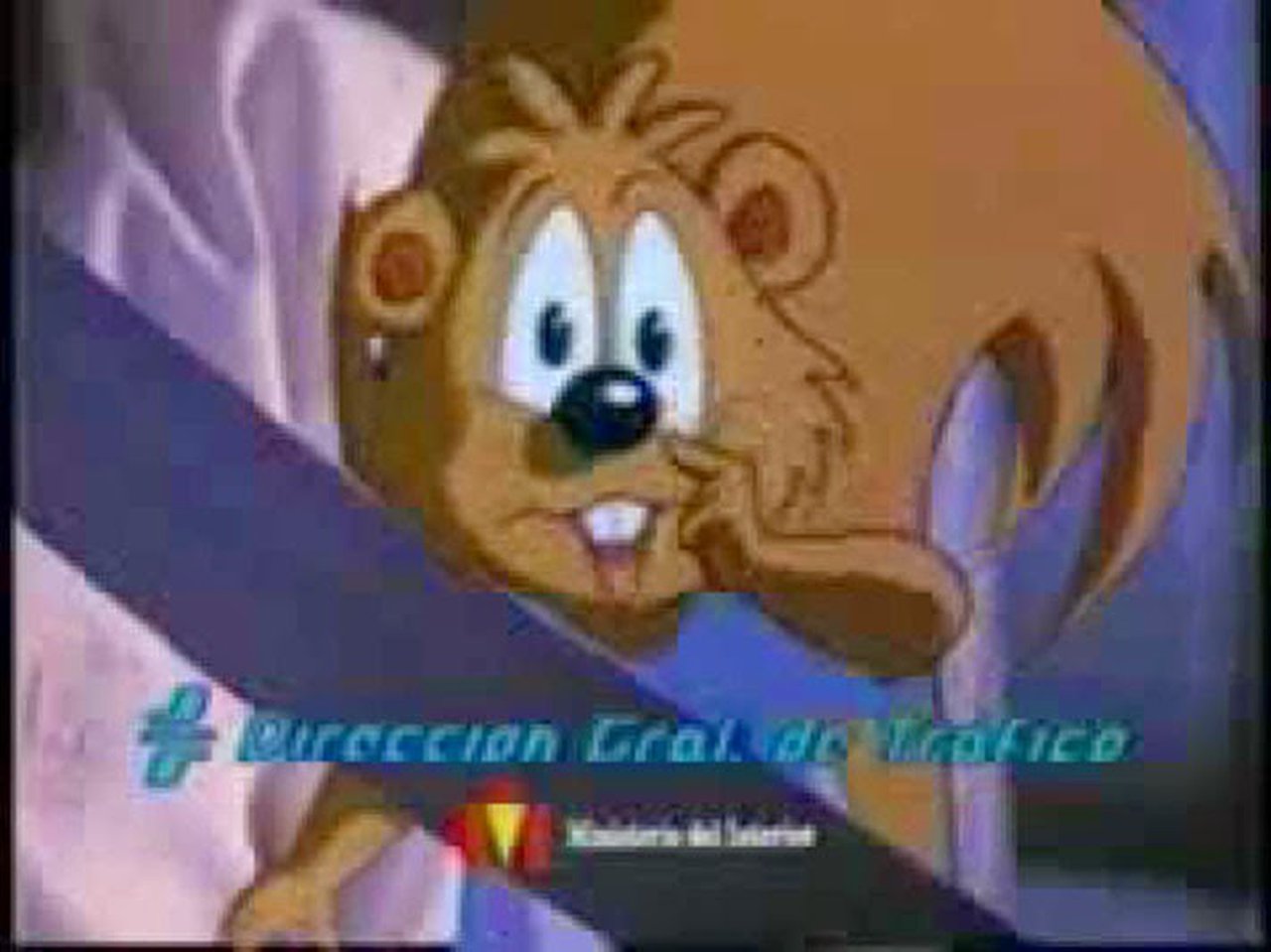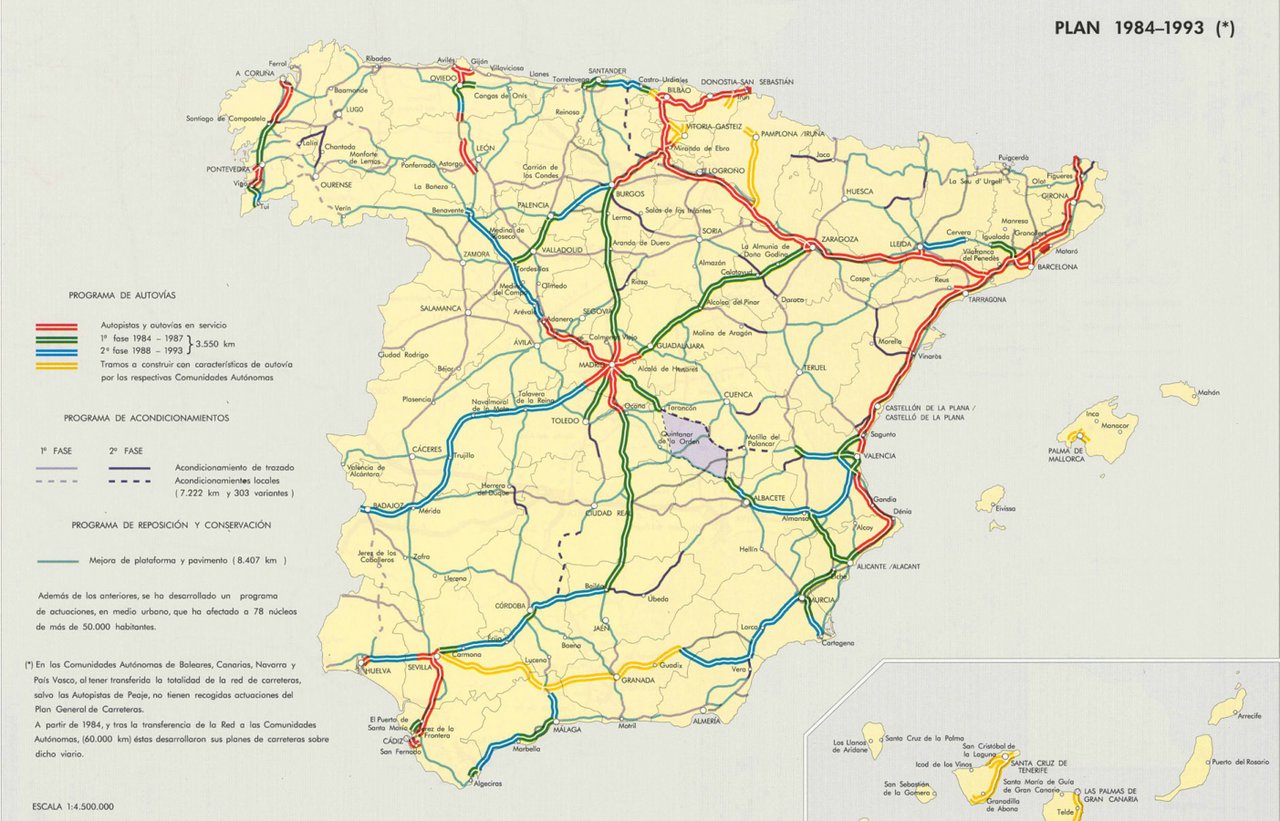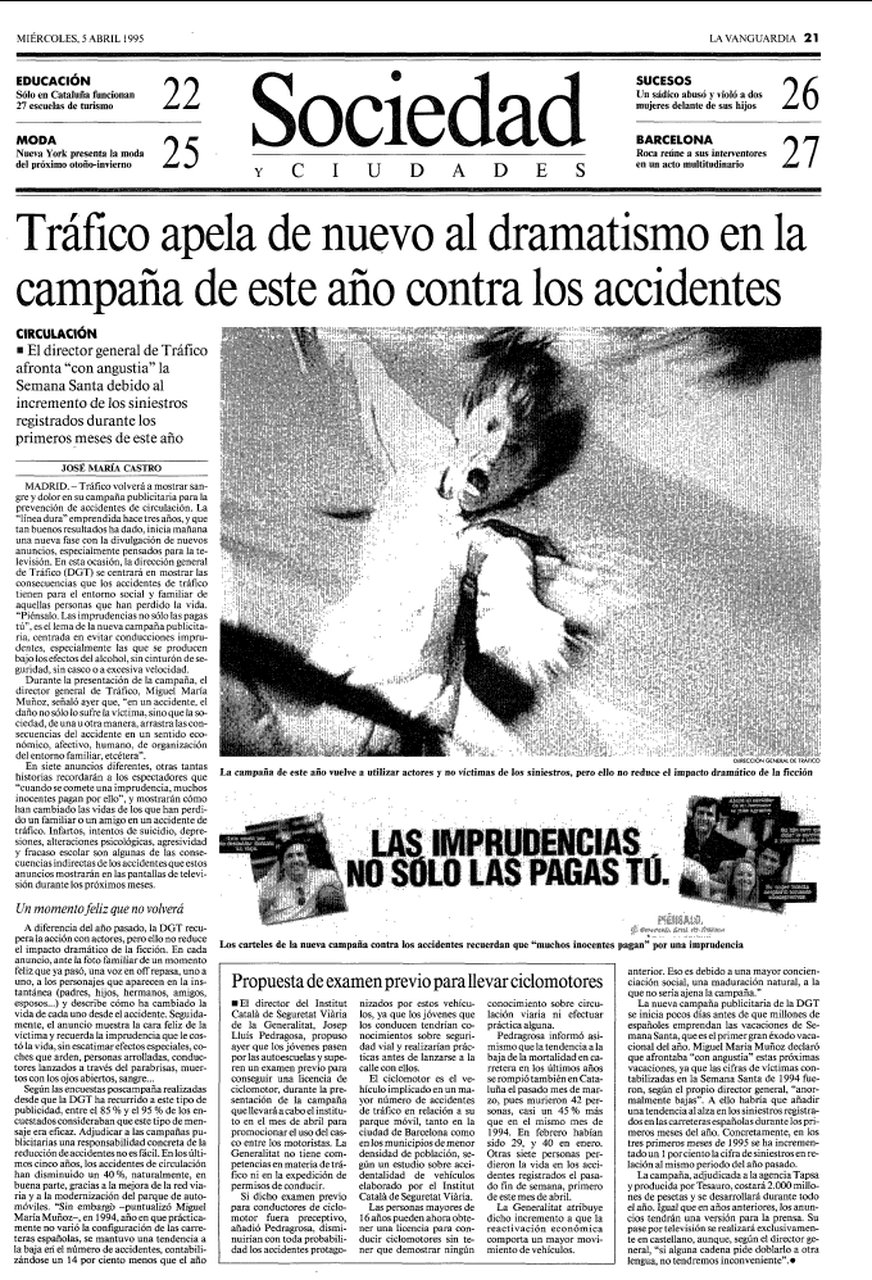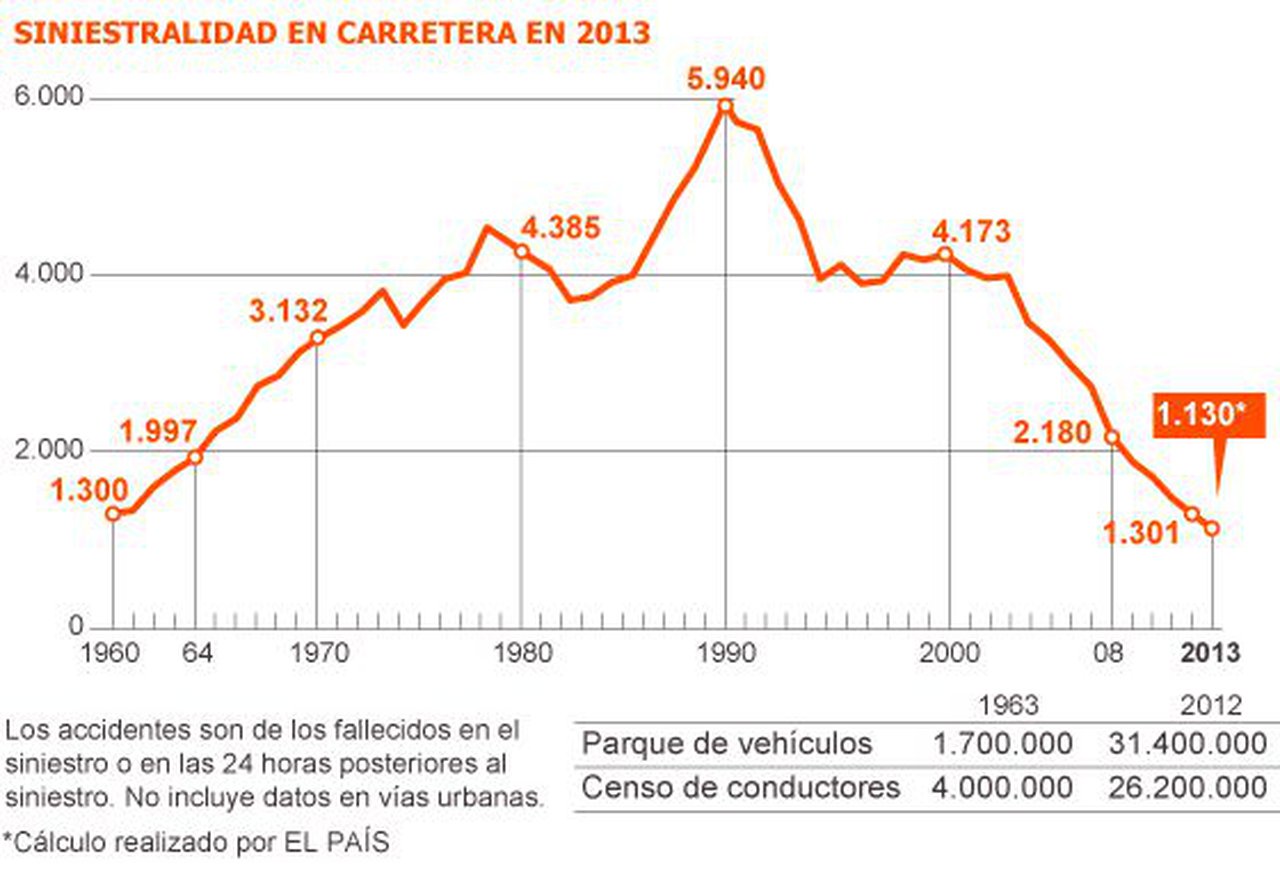
The Reckless Acts... When the DGT Shook Spain
There is a topic in Spanish advertising that has hardly been discussed in the media or on blogs: the series of awareness campaigns launched by the Dirección General de Tráfico (DGT – the Spanish Traffic Authority) in the early 1990s and the impact they had on society. Today I will try to fill this rather surprising gap because, exactly twenty-two years later, they still form part of the collective memory of several generations, are regarded as the advertising campaigns that saved the most lives, and, without a doubt, constitute an important part of the history of Spanish advertising.
The origin of these campaigns dates back to 1990. In Spain, one person died on the roads every hour and a half, 17 people a day, 5,940 people a year. This situation was unsustainable, especially for a country that, within a couple of years, would be in the global spotlight due to the Barcelona Olympics, the Universal Exposition in Seville, the Fifth Centenary of the Discovery of America, and the Ibero-American Summit in Madrid. At that time, the Socialist government of Felipe González had already been using European funds for several years to improve the outdated road network, while technological advances such as airbags and ABS brakes were beginning to become widespread in vehicles.

Nevertheless, to reduce accident figures, all these measures had to be accompanied by a radical change in the mentality of Spanish drivers, who needed to become genuinely aware of the dangers of road accidents. Aware of this challenge, the Director General of Traffic since late 1988, Miguel María Muñoz Medina, pushed forward two fundamental initiatives to raise public awareness. On the one hand, an update of traffic legislation, which toughened fines and penalties for road safety offences, and on the other, a change in the tone of the DGT’s advertising campaigns. In 1992 he successfully completed both projects: first, with the approval of the Law on Transit, Motor Vehicles and Road Safety, and second, as we shall see later, with the launch of the campaign “Reckless acts are punished... more and more severely”.
As I mentioned at the start of this article, I wanted to focus on how advertising was used to bring about that profound change in Spanish drivers’ mentality. Perhaps the first thing to say is that the campaigns the DGT was running up until 1992 were not at all bad. For example, in the 1985 advert the phrase “Si bebes, no conduzcas” (If you drink, don’t drive) was coined, featuring Stevie Wonder driving around while his song “Don’t drive drunk” from the The Woman in Red soundtrack played. This phrase became so popular at the time that today it is almost a social catchphrase:
Or the 1990 campaign, which won the Gran AMPE de Oro, the most prestigious advertising award in Spain at the time:
All the campaigns up to that point could be classified as soft or friendly adverts and, although they explained what drivers should do when getting behind the wheel, they perhaps failed to convince them to actually follow the advice. For this reason, the DGT’s director, Muñoz Medina, decided that it was necessary, as other countries were already doing, to run harder-hitting campaigns that directly targeted viewers’ emotions. I have not been able to determine whether he took this risky gamble before or after the advertising executives from a small agency called Clarín came to his office and suggested the “Reckless Acts...” campaign. In any case, the Muñoz Medina–Clarín duo changed the way road safety adverts were made in Spain forever. Thus, an audience accustomed to spots like this one from the 1989 campaign:
was confronted, on 25 June 1992, just before the summer holidays and right at dinnertime in prime time, with the following piece:
This realistic advert, without music, shot with a handheld camera,[2] set in the moments immediately after a road accident, featuring a young man screaming on screen “God, I’ve killed my mother!”, left half of Spain with a lump in their throat. The piece already seems strong enough today, but let us remember that television was very different back then. Although private channels had been around for two years, Spanish viewers were still not as desensitised to violence and blood as they are now. Nor did many households have remote controls, so despite the harshness of the advert, in many homes it was not possible to do zapping. Throughout the rest of the night, the other ads in the campaign were broadcast, equally hard-hitting, tackling the other major issues the DGT wanted to highlight: drink-driving and pedestrian fatalities, young people and weekends, safe distance and helmet use:
The next day, the whole country was talking about the campaign at work, in bars, and even on the radio and in the press.
Probably the most repeated phrase on 26 June was “Did you see the DGT advert last night?”. Amid widespread astonishment,
strong criticism and calls for the adverts to be withdrawn soon followed. However, the DGT director defended them tooth
and nail in front of the media and politicians and, despite intense pressure, kept them on the air throughout the summer,
alongside the broadcasts of Barcelona ’92 and the special programmes from Expo Seville.
In this way, “Reckless acts are punished... more and more severely” became the most far-reaching advertising campaign of
the moment and, as subsequent surveys showed when measuring its effectiveness, it more than achieved its objectives[3]:
although most respondents thought the campaign was harsh and unpleasant, they also considered it effective and necessary
and, most importantly, related what they had seen in the adverts to their own behaviour as drivers and pedestrians.
Given the success and, above all, the impact caused, the following year the DGT and Clarín skilfully prepared a follow-up campaign entitled “In the end... reckless acts are punished”, which aimed to remind viewers of the terrible consequences that certain negligent behaviours and attitudes on the road could have. The new adverts showed viewers what had happened to the protagonists of the previous campaign and how their lives had changed a year after their traffic accidents.
There is no doubt that the spots, with their music and scripts, were designed to make audiences feel uncomfortable. The continuous, almost subliminal flash-backs ensured that viewers did not forget the tragedies caused by reckless behaviour on the road. Of course, the effect these adverts had on Spanish society was not the same as that of the first campaign, first because the creatives did not intend it to be and second because they could not (and probably no one ever could again) cause such a level of general unease among viewers, who were beginning to tolerate the new, more hard-hitting and violent audiovisual codes. Nonetheless, the second Reckless Acts... campaign was once again a success, achieving penetration levels above 75% and recall levels above 90%.[3]
In 1994, following a public tender with sixteen applicants, the agency Casadevall Pedreño & Piera Vallejo took over from Clarín, launching a series of adverts that continued the Reckless Acts... series and took things a step further. This time, instead of dramatised scenes with actors, the adverts featured testimonies from real traffic accident victims, explaining how their reckless behaviour had changed their lives. Before each account, every spot reminded viewers of the penalties associated with the offence that caused the protagonist’s accident, while a voice-over delivered the campaign’s slogan: “Reckless acts... can cost you dearly, or very dearly.” These adverts stood out for their journalistic style: a fixed tripod camera, background noise, and victims speaking directly to camera. The stories varied in strength, with some even containing touches of humour.
A total of twenty-six different adverts were prepared to prevent viewers becoming desensitised to the messages, which were broadcast before the Easter holidays.[4] The campaign was once again a success and achieved even greater penetration than the previous year. Respondents in the effectiveness surveys pointed out that the real testimonies made them feel more aware of the dangers of traffic accidents.
For the 1995 campaign, expectations were sky-high after the successes of the previous three years. The previous season, the agency Casadevall Pedreño & Piera Vallejo had run into problems with the DGT after telling the newspaper El País [5] that the adverts they had prepared would feature real testimonies,[6] so that year the winning agency, Tapsa NW, was required to maintain absolute secrecy about the work they had prepared, under threat of not being paid or hired again by the DGT in the future. The reason was simple: the DGT campaigns following “Reckless acts are punished... more and more severely” had generated such anticipation that the launch of a new campaign was a major event for television, radio and the press. A leak would have wasted that highly valuable publicity.

On 4 April 1995, the campaign was unveiled in time for the Easter holidays. That year, the creatives at Tapsa focused on the consequences a traffic accident has for the friends and relatives of the victims. To this end, the adverts showed each family member and friend one by one in cut-outs from a group photo, while the long-term effects of the accident on each of them were explained. The spots ended by revealing the error that had caused the accident, at the same time as the complete photo was shown with the victim at the centre and, for the first time in Spain, explicit images of the accident itself.
This campaign was once again quite successful, but for the first time surveys showed signs of audience fatigue. The violent images at the end of the advert, which the creatives had added to try to capture attention and generate debate, were not well received by respondents, who judged them unnecessary. This was the least effective campaign of the series, but it remains one of the most remembered today.
The following year, the Popular Party won the general elections, ending fourteen years of Socialist government, and Miguel María Muñoz Medina handed over his post as Director General of Traffic to Carlos Muñoz-Repiso Izaguirre. That year’s campaign, “The solution is in your hands”, while maintaining a tough advertising line, broke away from the Reckless Acts... series, thus closing a chapter in advertising history.

Until the launch of “Reckless acts are punished... more and more severely” no advertising campaign had ever managed to generate such a strong social debate, not only about the violence of the adverts but also about traffic accidents and their causes. For the first time, the DGT succeeded in getting all the media to talk about its campaigns, generating an annual anticipation for its adverts that has never since been matched with the same intensity. From a stylistic perspective, the adverts were also completely groundbreaking: at a time when advertising still carried the dust of the 1980s, with jingles, cheerful women with teased hair and Jean Michel Jarre-style music, the display of such harsh images made all Spanish viewers shudder. Their effectiveness was not only measured in post-campaign surveys: all road safety experts agree that these DGT campaigns made a very significant contribution to the sharp decline in road fatalities that occurred between 1992 and 1995, precisely the years when Reckless Acts... were broadcast. I cannot think of a better example of the power of advertising to change society.
[1] Atlas Nacional de España. Sección VII, Ministerio de Fomento, 2008
[2] It is striking that this advert was shot three years before the start of the Dogme 95 movement.
[3] Eficacia de las campañas publicitarias de la Dirección General de Tráfico, Laura Atienza Cernuda, Máster en Investigación
en Economía de la Empresa, Universidad de Valladolid, 2009
[4] Las nuevas campañas divulgativas de la DGT, Luis Montoro González, Enrique Carbonell Vayá, Papeles del Psicólogo,
nº 58, Febrero 1994
[5] Tráfico desvela hoy el secreto
de su campaña publicitaria en televisión, El País, 4 de abril de 1995
[6] Tráfico mostrara en sus
anuncios a heridos graves por imprudencias en la conducción, El País, 3 de febrero de 1994
[7] Image source: El
País
|
Next post: Frequency, Period, Wavelength, Wavenumber, and the Colors of the World Cup |
Previous post: The Origin of the Autonomous Community of Castile and León (Part III) |